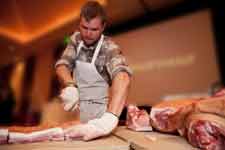To understand where your meat comes from, you have to appreciate the process it went through from live animal to that lovely roast sitting in the display case. It can be a convoluted process, starting in one country and ending in another, or it can be quite simple and elegant- being killed and cut up on the same farm it was raised. More than likely it is somewhere in between.
A lot of people with different professions take part in that process, most notably the butcher. There are diverse kinds of butchers too, from those that do the animal slaughter, those that break down whole carcasses for wholesale markets, and those that cut up sides or sub-primals into retail cuts or further processed meats like bacon, jerky, or salami. Even some restaurants employ butchers or charcuterists- those that cure meats like salami or hams. In small meat processing facilities there is less specialization, so employees often do it all from killing the animal, gutting it, and then breaking down the carcasses into cuts. A bigger plant, such as Smithfield or IBP, assign employees to just one task that they perform all day, such as eviscerating or cutting the animal carcass in half. These folks are less like butchers and more like factory workers on an assembly line, although they may have knowledge of whole animal butchery that they simply don’t get to utilize.
There are butcher counters in a lot of grocery stores, however the amount of real butchery going on in those places is often negligible. They may be thawing out frozen meat to put into the display case or opening up 50 lb. boxes of steaks and giving them a little fat trimming. Newer neighborhood or on-farm butcher shops and those that survived tucked away into little corners of our nation over the last 50 years are resurrecting many of the traditions of whole animal butchery, curing and smoking techniques, and teaching people how to cook all of the animal once again. There is certainly value in this, particularly in the re-education of home cooks. They still aren’t going to convince every consumer in America to eat kidneys again or return to the Sunday pot roast tradition, but every bit probably helps create a more reverent consumer and the preservation of skill.
Currently the media is giving ample coverage to these retail butchers- the chap or gal in the handsome apron, rolled-up sleeves, smiling at you behind a case of meat they may or may not have cut up. But what about the butchers at USDA or state inspected slaughterhouses that make this pretty meat possible for retail markets (all meat sold in this country has to be processed under inspection). They can be skilled butchers too but rarely get the accolades.
Chris Fuller and his crew of 5 employees at Alleghany Meats should be getting that spotlight. These folks are rebuilding the small-scale, regional meat-processing infrastructure that is critical to the resurgence of independent family-scale farming and the return of the neighborhood butcher shop that all but disappeared over the last few generations. Without these small plants, you can be sure your meat came from the likes of Cargill or Tyson, who own most of the large slaughterhouses around the country. The big difference is that small plants do processing as a service to farmers, whereas the corporate plants won’t touch your animal unless they own it and bought it for pennies. The financial difference can be huge. For example, if you sold your 225 lb. hog to an industrial meat packer you may be paid $60. If you got it processed yourself at an independent facility and sold cuts at a farmers market, you may gross over $600 for the same pig.
Chris Fuller, who grew up in Connecticut and spent his formative years in Colorado is a meat craftsperson to know. Equal parts slaughterer, butcher, educator, and administrator, Chris performs it all at a new meat plant in the heart of Appalachia.
He found a fledgling company in Virginia looking for a General Manager to start their new USDA-inspected meat plant. He applied and got the job, after spending several years cutting meat in Colorado building his repertoire of skills. In April of this year, Alleghany Meats opened for business in the tiny town of Monterey, Virginia. A joint project of the non-profit The Highland Center and almost 100 small investors, many of them farmers themselves, financed the planning and building of the plant. The purpose of Alleghany Meats is to serve the livestock farmers of the mountainous border region as well as provide some living wage jobs to locals. Farmers using this plant are now able to direct market their meat at farmers markets, to restaurants, or buying club and thus earn more income. The plant is currently seeking humane slaughter certification and offers basic butchering and packaging of four-legged livestock. In the coming months Alleghany Meats will eventually add some further processing such as smoking and curing.
Although many new retail butcher shops are opening around the country and certainly provide consumers with more meat eating options, according to Chris, they aren’t really going to solve for any of the pressing problems in the meat supply chain. “They won’t solve the distribution issues or lack of consistent volume throughout the year that small producers face,” he remarked when talking about how to get meat from independent, family-scale producers into the retail setting such as butcher shops or restaurants. There just aren’t enough processing facilities, nor are there sufficient things like cold storage, refrigerated trucking, and ethical middlemen that pay the farmers fairly.
Small processors like Alleghany Meats can help ameliorate that infrastructure gap. Likewise, Chris believes the small butcher shop model will be challenging, “there is a reason that small shops closed down over the last 50 years”. Consumers shop differently now and dealing in small meat volumes has high transaction costs in a meat supply system that deals in large quantities and boxed meat. There are of course butcher shops that are bucking that trend of anonymous, mass-produced meat. One shop in La Jolla, CA actually produces it’s own grassfed beef within the same county. Another butcher shop in Bow, WA sells meat from the farmers who cooperatively own the processing business. Yet another business in central Kentucky slaughters, butchers, and markets meats for a variety of local KY producers, requiring rigorous animal welfare standards and transparency. It will be interesting to see if and how consumers respond and show loyalty to these kinds of retail shops striving to uphold more sustainable ethics. Many of the business models are still too young to interpret their sustainability or predict their staying power.
The characteristics of a good butcher, in Chris’s opinion, is a deep understanding and respect for the animal and the meat, striving to maximize the value of the carcass, skilled cutting, attentive customer service, and overall business savvy. He is bringing those skills and compelling ethics to the world of meat processing, helping farmers bring more homegrown meat to the marketplace.
Rebecca Thistlethwaite is the author of the forthcoming book Farms with a Future: Creating and Growing a Sustainable Farm Business. She runs a farm and food business consulting firm called Sustain Consulting and is starting a small homestead in Washington with her family. Rebecca also serves on the board of the Sustainable Food Trade Association and writes her own blog Honest Meat. Her other recent pursuits include training oxen, trail running, and learning how to make fermented foods.


